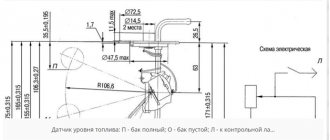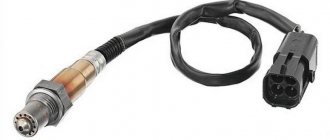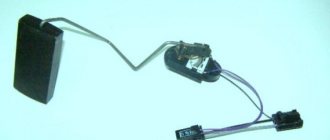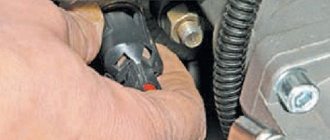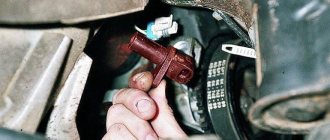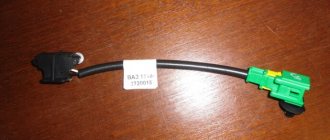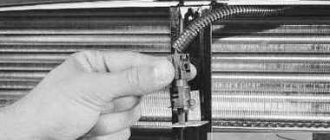The anti-lock braking system is an integral option of any modern car from economy to premium class. The ABS system allows you to drive a car comfortably and safely on any surface, even the most difficult. During the operation of the car, the driver may encounter the problem of a non-functioning anti-lock braking system (ABS) and, as a result, ineffective braking of his car. In this case, the ABS sensor may need to be replaced. Depending on the age and condition of the vehicle, replacing an ABS sensor can be quite a labor-intensive process.
First, you need to study the available technical documentation regarding the operation of the ABS on a specific car model. On VAZ cars, the ABS system consists of the following parts:
- ABS activation sensors, 4 pcs. (one for each wheel);
- ABS control unit;
- Hydraulic pressure modulator.
ABS control unit
ABS sensor
ABS pressure modulator
By the way, having such a set of spare parts, you can install an anti-lock braking system even on those VAZ models that do not have such a system.
Installing ABS on a VAZ is one of the best ways to improve the vehicle's handling and safety. Let's consider the installation process (you will also need new calipers, brake pads and outer CV joints; these parts will fit from Lada Priora).
- 2 Replacing the ABS sensor
2.1 Work plan
Replacing the ABS sensor
The anti-lock braking system (ABS) prevents the wheels from locking when braking, eliminating the risk of losing control of the vehicle and maintaining its stability when driving. Due to its reasonable cost, this equipment is widely installed on modern automotive vehicles. An important role in the operation of the system is played by touch sensors that are mounted on the hubs and record the speed of rotation of the wheels.
How to disable ABS on a Lada Priora with your own hands: video instructions
One of the negative factors in car operation when ABS is turned off is an increase in braking distance, which is especially noticeable in poor traffic conditions, on wet and slippery roads, as well as in snowfall. There may also be problems with the vehicle's handling. Among car enthusiasts there is no clear opinion about whether it is good or bad to have ABS, but some turn it off. This material will discuss exactly this, but we emphasize that responsibility for all the consequences of such manipulations lies with the owner of the car, and whether the ABS can be turned off or not is up to everyone to decide for themselves. Let’s immediately make a reservation that, as experienced car owners note, including incorrectly disabling ABS on the Lada Priora, this can lead to operational problems, as well as unnecessary questions in service centers. Moreover, if the car is under warranty, the fact that the ABS is turned off may even lead to warranty service being denied.
Purpose of the ABS sensor and operating principle
The ABS sensor is one of the three main components of the system, which also includes the control module and hydraulic unit. The device determines the moment of wheel locking based on its rotation frequency. When this undesirable event occurs, the electronic control module receives the sensor signal and forms an effect on the hydraulic unit installed in the line immediately behind the main brake cylinder.
ABS sensor with wire and connector
The block reduces or even stops the supply of brake fluid to the locked wheel cylinder. If this is not enough, the solenoid valve will direct the fluid into the outlet line, relieving the pressure already in the master cylinder. When wheel rotation is restored, the control module removes the pressure from the valves, after which the hydraulic line pressure is transferred to the wheel brake cylinders.
Each wheel of the car is equipped with an ABS sensor.
Replacing the ABS block
For repair you need to prepare:
- key "13";
- ratchet;
- head "10".
The procedure for working with Priora is as follows:
- Stop the car and raise it. Disconnect the minus from the battery.
- Drain the brake fluid from the cylinder brake hose.
- Unscrew the brake pipes connected to the block. There are 6 of them in total.
- Unhook the power lock and disconnect the wires.
- Unscrew the nuts fastening to the car body.
- Slowly pull the block and remove it.
- Install the unit by connecting everything in reverse order. Don't forget to bleed the brake system.
The need to replace the device
Malfunctions in the ABS system are indicated by a warning lamp located on the dashboard of the car. In normal mode, the indicator lights up when the engine starts and goes out after 3–5 seconds. If the controller behaves incorrectly - it turns on while the engine is running or blinks chaotically when the car is moving - this is the first sign of a sensor failure.
The ABS indicator should go out 3-5 seconds after starting the engine
Also, a possible device malfunction is indicated by:
- an error code appears on the on-board computer display;
- continuous wheel locking during heavy braking;
- absence of characteristic vibration on the brake pedal when it is pressed;
- the parking brake indicator lamp has been activated when the handbrake is off.
If any of these problems occur, the device should be fully diagnosed. It is not at all necessary to trust this question to highly paid car service technicians - checking the ABS sensor yourself takes little time and is done without expensive equipment. If diagnostics reveal that the device is broken, it will have to be replaced with a new one.
What is ABS
Subaru Forester 2.0 IS EyeSight Cross Logbook Classic Emblem for Forester
The anti-lock braking system was developed when it became clear that when the wheels suddenly jam, the car loses stability and is difficult to control. Moreover, the quality of braking did not improve, and the car was pretty much carried off the road. Therefore, a system was developed that, by regulating the pressure in the brake system pipes, allows the wheels to turn slightly. This significantly improves vehicle dynamics, allowing the driver to control the vehicle more confidently. But despite its apparent simplicity, this is a rather complex process that requires the coordinated operation of many mechanisms included in the anti-lock braking system. If any of the components fails, a warning lamp lights up on the instrument panel.
Important! You can often hear the question from drivers: “Why is the ABS sensor on?” It is important to know that when the warning light comes on, it does not necessarily indicate a faulty wheel sensor.
How to change
According to the ABS scheme, all wheels of the car are equipped with sensors. The peculiarity of their replacement is that the elements installed on the front axle of the car are removed from the bottom of the body or from under the hood of the car. The rear sensors can only be accessed from below. This instruction describes the general principles of replacing the device. Note that this method is applicable to many foreign and domestic cars.
Tools
To change the sensor you will need:
- reliable jack;
- wheel wrench;
- a set of open-end and socket wrenches;
- hammer;
- flat screwdriver;
- metal conditioner WD-40;
- tester (multimeter).
Phased replacement
We will consider the step-by-step execution of work using the example of replacing a device installed on one of the rear wheels of a car.
- Let's park the car on a flat surface and activate the parking brake (handbrake). We will place wheel chocks under the wheels that are not involved in repair work. Remove the negative terminal from the battery.
- We dismantle the rear row of seats, the plastic trim of the threshold and the rubber door seal.
- Let's get to the sensor connector - bend the clamps and pull out the plastic trim in the area where the shock absorber is mounted. Let's disconnect the device.
View from the interior: 1 — connector; 2 — clamp; 3 — overlay; 4 - sensor wire
The wheel must be removed by installing safety supports under the bottom of the car.
View of the rear part of the hub: 1 — bracket; 2 - mounting bolt
View of the arch: 1 and 2 — sensor wire fixation points; 3 - plug
Attention! Before installing the trim elements, turn on the ignition and start the car engine. Only after making sure that the ABS indicator lamp behaves correctly (it goes out 3-5 seconds after the start) do we continue to work.
As a visual aid to help you replace the device, we offer the following video.
Video: How to change the ABS sensor on Renault Logan
Why does the ABS light even come on?
In a normally running vehicle, this indicator shows you that the wheels have been unlocked. In this case, everything works fine, the sensors sensed the need to turn on the safety system, initiated its operation and demonstrated to the driver that some assistance was provided when braking. When you see the ABS light on while braking, it is better to release the brake pedal a little and take over control of the car. If you have an expensive, high-tech car, you can trust the well-thought-out systems and let ABS+EBD do the job. In other cases, the light may be on for the following reasons:
- the sensors are clogged, the on-board computer indicates that the diagnostic error code should be read;
- Dirt or rust got on the sensors, which caused the anti-lock braking system to turn on incorrectly;
- there is a problem in the on-board electrical system, which is demonstrated by random lights coming on;
- the wheel bearing has failed, which forces the sensors to constantly turn on the anti-lock braking system by mistake;
- the fuses in the unit responsible for the ABS system have failed and are passing the signal directly;
- There was an error in the computer that caused the ABS light to come on.
Also, sometimes troubles occur with the generator and other elements of the machine’s electrical circuit, which can result in the lighting of the diagnostic system light or warning lights of any type. For example, on a Volkswagen car produced in the 2000s, the anti-lock braking system light comes on even if there is an error in completely different components. Therefore, self-diagnosis is only a partially acceptable method of solving the problem, because often the driver does not have special tools at hand for a good investigation.
- there is no contact in the connection connector;
- break in the wire to the sensor (check the wires);
- The ABS sensor is faulty (check and, if necessary, replace the ABS sensor);
- the crown of the hub has become unusable;
- The ABS system control unit is faulty.
If you look at the instrument panel and see that the ABS icon does not go out and is constantly on, then the first thing you need to do is check the fuse for this system. If the fuse is working, then inspect the sensors on the wheels.
The reason for the sensors on the wheels not working may be oxidation of the sensor connector on the hub (this often happens in areas where roads are treated with various chemicals and reagents) or the presence of dirt on the connectors.
It also happens that the ABS sensor connection wires fray, which is why there is no full contact or the contact works intermittently.
It also happens that you recently changed the brake pads or the hub and simply forgot to connect the ABS sensor connector plug.
If there is a working ABS system during heavy braking, when the wheels are stopped by the braking system, and the car continues to drive, the ABS system is activated and releases the wheels, then locks again, then releases again, then locks again, as long as you hold the brake pedal pressed and the car will continue to move.
In cars without ABS, if you press the brake and the car continues to move due to a slippery road surface, then you need to brake jerkily: press all the way and release, press and release, in this case control of the vehicle is maintained and the braking distance is reduced. I experienced this myself when I had a car of the VAZ 2106 family. When I was driving it in the evening in rainy weather, there were cars standing in front of the traffic lights at the traffic light, I drove up from behind and pressed the brake, the “six” continued to move due to a coating of dirt on the asphalt, I had to press the brake all the way several times, so to speak, to use myself instead of ABS. The car stopped safely.
When driving a car with ABS, you must press the brake pedal all the way for the anti-slip system to work. Do not use the intermittent braking method, as on a car without ABS.
Also, sometimes the ABS light comes on when the wheels slip. But this is not critical. You just need to apply hard braking a few times and the ABS light will go out.
If, suddenly, after all the checks (wires, sensors, cleanliness of contacts, hub crown, control unit) the ABS light is still on, then you will have to carry out computer diagnostics at a service center or, if you have a scanner, with your own hands. The brake system may be air-filled; in this case, it is necessary to properly bleed the ABS brakes.
Checking the quality of work performed
After replacing the sensor, its functionality is checked. To do this, it is enough to accelerate to a speed of 40 km/h on a flat, safe section of the road and perform sharp braking. If the car stops without pulling to the side, vibration is transmitted to the pedal and a specific sound of brake pads being activated is heard - the ABS system is operating normally.
Today you can easily find and buy any ABS sensors - from expensive original devices to analog parts at an affordable price. Remember that proper selection of system elements plays an important role in its uninterrupted operation. When choosing a sensor, study the manufacturer's instructions and make sure that it fits the car, and this review will help you replace the device yourself.
Is it possible to repair the sensor?
In the event of a malfunction, the device requires replacement (how to remove the ABS sensor was discussed above). Before starting work, contact your dealer and order a new part. After carrying out the work, test the device to ensure it is working properly. To do this, find a flat section of the road, accelerate the car to 30-40 kilometers per hour, and then sharply squeeze the brake.
If everything is done correctly, then impulses will be felt under your foot, and the car will stop. If the wiring is damaged, the latter must be replaced, and then diagnose the system using the algorithm already discussed.
Remember that if the sensor fails, it cannot be repaired. The only way out is replacement. What can be fixed is the wiring, which is changed or repaired with a soldering iron and electrical tape.
When connecting the wiring, be careful and take into account the polarity of the sensor. To avoid mistakes, look at the instructions, where the necessary symbols are indicated. Good luck on the roads and of course no breakdowns.
The serviceability of the anti-lock brake system is the basis for safe driving, especially in difficult road conditions. If, while driving a vehicle, the ABS system malfunction indicator lights up on the dashboard, you should immediately take measures to eliminate it.
p, blockquote 1,0,0,0,0 —>
p, blockquote 2,0,0,0,0 —>
Even if one of the ABS sensors does not work correctly, this leads to a complete failure of the anti-lock braking and traction control systems, and a malfunction of the exchange rate control system, if they are installed on the car.
p, blockquote 3,0,0,0,0 —>
p, blockquote 4,0,0,0,0 —>
Why does the ABS and ESC light come on?
ABS malfunction may be caused by:
- failure of wheel rotation sensors;
- malfunction of the hydraulic valve block;
- damage to the wiring.
If the ABS malfunction indicator light comes on, you must contact a service station as soon as possible for diagnostics (read error codes) and repairs.
The most common cause of ABS failure is damage to the wiring near the ABS sensor connector. It is located under the fender liner, but is still not well protected from moisture and dirt.
As a result, the wires oxidize and break, and the ABS lamp lights up.
Basic malfunctions of the ABS system
Any driver who has ever had an ABS light come on in a Priora will tell you about the sensor. But it could be worse - if the ABS in Priora does not work. There are several options in which to look for the source of the problem:
- wiring damage;
- mechanical damage to the brake fluid pressure valve block;
- failure of speed sensors.
The first thing you need to do when you see the light (ABS lights up) is to read the error symbols using a special diagnostic scanner. Each item in the ECU is indicated by a corresponding code:
- C0040 – the speed sensor (DSC) of the right front wheel is faulty;
- C0035 – DSC of the left front wheel is faulty;
- C0050 – DSC of the rear right wheel is faulty;
- C0045 – DSC of the rear left wheel is faulty;
- C0065 – front left valve (intake);
- C0060 – front left valve (exhaust);
- C0075 – front right valve (intake);
- C0070 – front right valve (exhaust);
- C0085 – rear left valve (intake);
- C0080 – rear left valve (exhaust);
- C0095 – rear right valve (intake);
- C0090 – rear right valve (exhaust);
- C0161 – the braking signal does not turn off;
- C0121 – power to the valves does not turn on;
- C0110 – electric return pump.
- C0550 – error in the “brains” - ECU;
- C0245 – error in receiving data from sensors;
- C0800 – power surges.
The solution may be simpler: an ABS sensor is installed under the fender liner. Dirt often gets into this area; an unprotected piece of wiring near the DSC connector can be damaged. Replacing it will help.
How to repair wiring
We remove the wheel, and then the locker (for the front wheel, turning out the fastening screws) or the protective shield (for the rear wheel, turning out the two fastening nuts “10”). Press the latch and disconnect the block with wires from the ABS sensor. We inspect the connector and make sure there is no corrosion or damage. In case of damage, we restore the integrity of the wires:
We treat it with a special means for cleaning electrical contacts (for example, graphite grease) and clean the contacts from oxides. We clean the wheel speed sensor and the surface around the sensor from dirt.
Attention! Keep ABS sensors away from magnets as this may cause damage.
What to do first?
It is necessary to check the ABS sensors located near each wheel hub. Your task is to detect a violation in the connection of the sensors, a broken wire or damage to the ABS sensor housing. In any of these cases, you will one way or another see the corresponding indicator on the panel, well, provided that the system control unit itself is working and not “buggy”.
Checking the ABS sensor - measuring the resistance
- We jack up the wheel on which you think the inoperative or faulty sensor is located, or each wheel in turn if you don’t know exactly which sensor is faulty.
- Next, remove the wheel and gain access to the sensor.
- Remove the housing, as well as the protective control unit and connectors that supply power to the sensors.
- After that, we insert wires into the circuit of wires with PIN connectors and connect them with the sensor and multimeter.
- We measure the resistance and compare it with the one that should be by default (you can find it in the manual) or with a representative of the manufacturer of your car.
- We check the wiring for breaks or short circuits.
- Rotate the wheel while watching the multimeter readings, the resistance should change.
- Device - leg - 5-26 Ohm.
- Device - "ground" - from 20 kOhm or more.
Checking the ABS sensor using a tester - measuring the voltage
- Let's jack up the wheel.
- Turn on the multimeter, set the DC voltage measurement mode.
- We connect the electrodes of the device to the connectors and check the readings, while rotating the wheel (about 1 rpm).
- A working ABS sensor will show a voltage on the device of ~0.25-1.2 Volts. If the wheel rotation speed is higher, the readings will increase accordingly.
How to check a sensor with an oscilloscope?
To diagnose the serviceability or malfunction of the ABS sensor, you can even use an oscilloscope or, more simply, a tester. When connected, a graph will be displayed on the device; using amplitude analysis, you can judge the serviceability or malfunction of the sensor.
The problem is that this device is not available at every service station, not to mention the garage in which you are going to conduct all your “experiments”. The device is expensive and quite difficult to understand, so to work with it you need to have certain knowledge and skills.
In modern cars, the ABS system has a self-diagnosis function; using special software, you can read the error code and then decipher it using a special table.
Replacing ABS sensors
If the cause of the malfunction is not in the wiring, but in the ABS sensor itself, we replace it. To do this, first unscrew the fastening screw with a Torx T30 key, and then remove the sensor wiring harness from the bracket. The photo shows a Lada Vesta car; on other Lada models the work is performed in a similar way.
Instructions for replacing the front wheel ABS sensor:
Instructions for replacing the rear wheel ABS sensor:
Checking the old sensor
It may be that installing a new sensor is not required at all, because... the old one could simply become dirty and for this reason refuse to work. To fix this, you need to very carefully clean the sensor and check its electrical connection to the unit (you can use a screwdriver with an electrical indicator). It is worth noting that in the vast majority of cases, cleaning the sensor is quite enough to solve the problem of missing ABS or early activation of the system.
However, if cleaning does not help or the sensor has completely “died”, then it will need to be replaced. When choosing a sensor, pay special attention to the part model. Remember that the sensors differ not only on different models, but also in the location of installation “front-rear”.
To install a new sensor, you may need additional tools - pliers and a piece of pipe (as a lever). Again, due care must be taken, since the ABS sensor is a rather fragile system. Having installed the sensor in its proper place, you need to screw in the mounting bolt. Then the wire going to the ABS control unit is fixed in place and connected.
How to modify the design
To protect the wiring harness from the environment, you can use a D-shaped seal. We lay the wires in it and wrap it with electrical tape. We put everything in the corrugation. We glue the cover covering the ABS sensor connector around the perimeter with the same sealant. This will prevent moisture and dirt from entering the area where the sensor and connector are located.
Attention! If the ABS fails, the brakes remain operational, but the braking efficiency is reduced, which is especially dangerous on some surfaces. See why.
ABS device on Priora
Like most modern car systems, ABS is computer controlled. But in addition to the electronic control unit, it also includes several sensors and actuators. The entire system consists of several elements.
- Electronic control unit (ECU).
- Sensors on wheel hubs 4 pcs.
- Brake fluid pressure valves in the system 4 pcs.
- EVN (Electric Return Pump).
- Warning light on the instrument panel.
Despite all its apparent simplicity, this is a rather complex, high-tech system. Each sensor transmits data on the rotation speed of the Priora wheel to the electronic control unit. Based on the data received, the control unit sends a signal to the brake system valve, which, when you press the brake pedal, releasing pressure, prevents the wheels from completely locking and starting an uncontrolled skid of the car.
Anti-lock brake control unit in hydraulic unit
Structurally, on the Priora, the ABS ECU is mounted together with the EWH and valves that regulate the pressure into a single unit - the hydraulic unit. It is located on the front left side member of the vehicle. The hydraulic unit is connected to the entire system by a common wiring harness. It includes pipes for supplying brake fluid to the working cylinders. An EWH is also installed here, increasing the pressure in the system.
Wheel hub sensor
The sensors that supply wheel speed data to the control unit are made on the principle of a Hall sensor. By the way, most rotation sensors use exactly this principle: changing the voltage on the semiconductor of the sensor, depending on the passage of a control point on the rotating disk near it. It is in correlation with the signals from the ABS sensors that the control unit manipulates the valves.
ABS malfunction warning lamp on the Priora instrument panel
What Priora drivers talk about – “the ABS sensor has come on” – is in fact a warning lamp for the serviceability of the anti-lock system. When the ignition is turned on, the orange “ABS” inscription will light up on the dashboard for about three seconds. If the system is working properly, then after three to four seconds the light will go out. In general, the principle of signaling from the “ABS sensor” is the same as from the warning lamp of the main ECU of the car, the well-known “check anger”.
The role of the ABS sensor in a car
The ABS sensor is used to accurately determine the moment at which a particular wheel locks, based on its rotational speed. In addition to sensors, the anti-lock braking system includes a hydraulic and control unit.
When the wheel is about to lock, a signal is sent from the electronic unit to the valve body. The hydraulic unit reduces and sometimes completely shuts off the supply of working fluid to the working brake mechanism of a blocked wheel. If for some reason this is not enough, a special valve will be activated and the liquid will be redirected along the outlet line.
How does ABS work?
With the advent of the new braking system, vehicle safety during emergency braking has increased. The system began to be installed in the 70s. The ABS system includes a control unit, a hydraulic unit, wheel brakes and speed sensors.
The main device of the ABS is the control unit. It is he who receives signals from touch sensors in the form of the number of wheel revolutions and evaluates them. The data obtained is analyzed and the system draws a conclusion about the degree of wheel slip, their deceleration or acceleration. The processed information is sent in the form of signals to the magnetic valves of the hydraulic unit, which performs the control task.
Pressure is supplied from the brake master cylinder (MBC), which ensures the appearance of pressure in the brake caliper cylinders. Thanks to the pressure force, the brake pads are pressed against the brake discs. Regardless of the situation and the force the driver presses the brake pedal, the pressure in the brake system will be optimal. The advantages of the system are that each wheel is analyzed and the optimal pressure is selected, thereby preventing wheel locking. Full braking occurs due to the pressure in the brake drive system, regulated by ABS.
This is the principle of ABS operation. On vehicles with rear-wheel drive and all-wheel drive, there is only one touch sensor, which is located on the rear axle differential. Information about the possibility of blocking is taken from the nearest wheel, and the command about the required pressure is transmitted to all wheels.
The device that controls magnetic valves can operate in three modes:
- With the inlet valve open and the outlet valve closed, the device does not prevent pressure from increasing.
- The inlet valve receives the appropriate signal and remains closed, without changing the pressure.
- The exhaust valve receives a signal that the pressure is decreasing and opens, while the inlet valve closes and the pressure decreases as the check valve turns on.
Thanks to these modes, the pressure decreases and increases in a stepwise system. If problems arise, the ABS system is deactivated and the braking system operates without its participation. On the dashboard, the corresponding indicator indicates problems with ABS.
How the sensor works
Different manufacturers install different versions and implementations of anti-lock braking systems on their cars. There are several types of sensors. Some of them operate on the principle of the magnetoresistive effect, while others operate on the basis of the Hall effect. There are passive and active sensors.
Passive sensors are inductive speed sensors. The design and operating principle are extremely simple. It is based on an ordinary inductor coil wound using thin copper wire. A powerful magnet and an iron core are installed inside the coil - also magnetic. The end part of the coil with the core is installed opposite the magnetic ring mounted on the hub.
The sensor operates on the principle of electromagnetic induction. While the coil is at rest, there is no signal at the sensor outputs. When the car begins to move, a toothed ring rotor will move near the sensor core. This will change the magnetic field passing through the coil.
Due to the alternating magnetic field, an alternating current is generated in the coils, which is transmitted to the control unit. Such a system is not subject to interference and dirt, but begins to work only when the speed reaches 5-7 km/h.
An active analogue appeared in the 90s. The sensors operate on the principle of a semiconductor diode - the direction of the electric current changes under the influence of magnetic fields. Such sensors are called magnetoresistive. There is also a Hall effect sensor, where a current is generated in a resistor placed in a magnetic field.
The magnetic field is created by means of a special ring, which is attached to the car hub and rotates with the hub. In the case of passive sensors, any changes in the magnetic field lead to changes in the direction of the electrons - resulting in a change in resistance. These changes in resistance are recorded by the electronic module or ECU.
In the active sensor version, a changing magnetic field forces electrons to move to one end of the element. As a result, a voltage is generated that is transmitted to the ECU.
Is it possible to fix a faulty sensor?
If the winding of an element is damaged, some car owners get out of the situation by rewinding the coil. However, practice shows that it is not always possible to restore functionality in this way.
Design and purpose of components
The anti-lock braking system consists of three main components:
- Wheel speed sensors
- Control unit (module)
- Actuator
Car ABS elements
As noted, this system is often used as a basis for others. At the same time, the components of a number of other systems are only an addition to the ABS.
Sensors
Speed sensors are very important components, since the operation of the ABS system is based on their readings. Based on the pulses they supply, the control module calculates the rotation speed of each wheel, and based on the calculations, the actuator is controlled.
Location of the speed sensor on the wheel hub
The ABS design uses two types of sensors. The first ones are called passive sensors. These elements are of the inductive type.
Their design includes the sensor itself, consisting of a winding, a core and a magnet, as well as a gear ring used as a driving element. The ring gear is mounted on the hub, so it rotates with the wheel.
Inductive type sensor
The essence of the functioning of the passive element is very simple - the winding generates a magnetic field through which the gear ring passes. The existing teeth, when passing through the field, influence it, which ensures the excitation of voltage in the sensor. The alternation of teeth with cavities ensures the creation of voltage pulses, which make it possible to calculate the speed of rotation of the wheel.
A negative quality of passive sensors is the lack of measurement accuracy when driving at low speeds, which can cause the ABS system to not work correctly.
Now, due to the existing drawback, passive sensors are not used in the anti-lock braking system and have been replaced by so-called active elements.
As in the first option, active sensors consist of two main components - the sensor itself and the setting element. But in active elements, sensors are built either on the magnetoresistive effect or on the Hall effect. Both options require power supply to operate (the passive elements generated it themselves).
As for the driving element, the design uses a ring with magnetized sectors (multipole).
Design and principle of operation of an active speed sensor
The essence of the work of active elements is different. In the magnetoresistive version, a constantly changing field (from the master ring) leads to changes in the resistance readings in the sensor. In a Hall element, this field changes the voltage itself. In both cases, an impulse is created, from which the rotation speed can be calculated.
Active type elements have become widespread due to their high measurement accuracy at any speed.
Control block
The ABS system control module, like other ECUs involved in car systems, is needed to receive and process impulses transmitted from wheel sensors. It contains tabular data on the basis of which it controls the actuator. That is, after receiving a signal from each sensor, it compares it with the information entered in the table, and based on the results obtained, it will determine what it should do.
In a car with a number of systems based on ABS, the control unit has additional modules responsible for the operation of its systems.
Actuating mechanism
The actuator (also called a hydraulic unit or ABS module) is the most complex in design and consists of a number of elements:
- solenoid valves (inlet, outlet);
- pressure accumulators;
- return pump;
- shock-absorbing chamber.
ABS unit design
In the classic scheme, only one line goes to the brake operating mechanism, through which fluid is supplied from the master cylinder. In ABS, the return line is embedded into it, but it only passes inside the module.
The inlet valve is the only element installed on the main supply line. Its task is to shut off the liquid supply under certain conditions; by default it is open.
How to replace the ABS sensor yourself
According to the anti-lock braking system, sensors are installed on each of the four wheels of the car. It is more convenient to remove the front wheel sensors from the bottom of the hub; in rare cases, they can be accessed from the engine compartment. The elements on the rear wheels are easiest to access only from under the arch.
For replacement work you will definitely need the following tools:
- High quality jack;
- Wheel bolt wrench;
- Set of open-end wrenches and socket heads;
- Hammer;
- Flat blade screwdriver;
- Liquid Key;
- Multimeter.
The first step is to place the car on a level surface and activate the parking brake.
Next, the seats in the back row, the plastic threshold, and the rubber door seal are dismantled. This way you can get to the sensor connector - to do this, bend the clamps and pull out the plastic panels near the shock absorber strut mount. The wires with the connector must be disconnected.
The jack is installed at the required point and the car is raised, the wheel bolts are unscrewed and the wheel is removed. Then unscrew the fastening elements of the sensor - if the bolts have not been unscrewed for a long time, it is necessary to generously treat the connection with liquid wrench. When the bolts are unscrewed, the part is carefully removed. Next, unscrew the bolts of the wire brackets - they can be found on the rack and wing arches.
To remove the wire, carefully bend the anti-vibration pads - the cable is secured under it. Use a screwdriver to remove the plug and pull out the cable. The new part is installed in the same way. Then the bolts securing the brackets are tightened, the wire is inserted so that it can reach the socket, and a plug is installed. The overlay is glued to its rightful place.
Next, the wheel is installed, the ABS sensor connector is connected to the socket, the door seal, threshold inserts, and seats are mounted in place.
Working with front sensors is much easier as they are more accessible in most cases. On most models, the sensors are mounted on the steering knuckle. The replacement process is similar to working with rear sensors.
ABS device on Priora
The main task of ABS is to prevent the wheels from locking during braking. To fulfill its task in Priora, the anti-lock braking system works like this:
- At the moment of braking, the ECU receives data from ABS sensors that read the speed (they are located behind the hubs).
- The anti-lock braking system ECU is a unit with internal brake fluid pressure valves and an electric return pump. Its location is the front left side member.
- When the sensors transmit data about a sharp jump - instantaneous braking of the wheels - the fluid pressure is gradually released using valves.
- A malfunction of any system leads to the transmission of an error signal through the computer, which appears to the driver as a “burning ABS on the dashboard.”
ABS control unit
Location of brake system elements with ABS on a car
| 1 – brake system high pressure line pipe; 2 – brake pedal; 3 – main brake cylinder; 4 – additional tank; 5 – vacuum brake booster; 6 – hydraulic control unit (HCU); | 7 – front disc brake mechanism; 8 – caliper; 9 – rear drum brake mechanism; 10 – parking brake lever; 11 – parking brake cable. |
When the rotor teeth pass near the sensor, the magnetic field of the sensor changes, resulting in a voltage pulse being generated. This voltage is proportional to the wheel speed and can be measured. Speed sensor
The speed sensor detects the rotation of the wheel and consists of a permanent magnet and a coil. Front wheel sensors receive information from geared rotors located on the drive shafts.
ABS warning lamp: The ABS and EBD warning lamps are located in the instrument cluster.
1)
Lights up for 3 seconds after turning on the ignition and then goes out.
2)
Goes off when the engine starts.
3)
If the lamp is constantly on, it means there is a problem with the ABS.
4)
The lamp is on during self-diagnosis.
5)
If the warning light lights up periodically, it means there are problems with the ABS and the vehicle systems operate as if the vehicle does not have ABS and TCS systems.
6)
The lamp lights up when the electrical connector is disconnected from the control unit
ECU. EBD (Electronic Brake Force Distribution) warning light:
1)
Lights up after turning on the ignition.
2)
Goes off when the engine starts.
3)
Lights up when the parking brake lever is applied.
4)
Lights up when the brake fluid level is low.
5)
Lights up if the electronic brake force distribution EBD does not work: – if there is a malfunction in the solenoid valve; – if there is a malfunction in more than one sensor; – if the ECU control unit is faulty; – when the voltage is exceeded.
Hydraulic Control Unit (HCU)
The Hydraulic Control Unit (HCU) consists of an electric motor pump and a valve block to control the ABS pressure. The sensor is located in the pump motor and transmits an output signal to the ABS unit, which determines the performance of the pump.
Front brake fluid pipe hole diameter: 4.8 mm Rear brake fluid pipe hole diameter: 4.8 mm
A dual-circuit pump provides the required pressure, and a valve block distributes the pressure transmitted to the wheel brakes.
| A – front right inlet valve; B – rear left inlet valve; C – rear right inlet valve; D – front left inlet valve; E – front right exhaust valve; F – rear left exhaust valve; G – rear right exhaust valve; H – front left exhaust valve; M – + engine; N – motor (GND). |
ABS self-diagnosis
The ABS control unit begins to perform self-diagnostic functions after turning on the ignition. The ABS control module detects faults for each circuit and component by comparing the system condition to a limited set of conditions in the ABS control module. The ABS control unit stores the fault code and then displays it to the scan tool as four-digit codes.
Checking Self-Diagnostic Codes
| EXECUTION ORDER |
| 1. Turn the ignition key to the OFF position and connect the scan tool to the scan connector located near the vacuum booster in the engine compartment. |
| 2. Turn the ignition key to the ON position and set the vehicle model and diagnostic tool model on the device. |
| 3. Select the parameter to be tested after the block is initialized. |
| 4. Press check codes #1 and find out if a fault is recorded. |
| Warning The fault code is a four-digit number that appears continuously until the fault code is cleared by the diagnostic tool. |
| 5. Using the list of fault codes, identify the faulty element and restore its functionality. |
| 6. After erasing the fault codes from the memory of the ABS control unit, select inspection point No. 4. |
How to recognize that the ABS sensor is no longer performing its functions
On older cars, a malfunction of the ABS sensor can lead to the most unpleasant consequences. If the wire breaks, the voltage may not reach the computer, just like when the wheel is locked. Therefore, a simple computer assumes this situation is that one of the wheels is blocked. Ultimately, Abs begins to unlock one wheel during braking, which can completely disable the braking system, and during a critical stop, provoke a complete loss of control right before the car turns over. Signs that the ABS sensor is faulty are:
- after inadequate operation of the system, the message “Abs” appears on the dashboard, the module stops working;
- on modern cars, after starting the engine, the ABS light does not go out, and the system stops working;
- during weak braking, the pedal vibrates, the brake force dispersal system is activated;
- auxiliary brake systems, amplifiers and balancing devices operate constantly;
- the on-board vehicle displays a number of problems that are related to the operation of the anti-lock braking system;
- When connected to a diagnostic computer, an error code for the anti-wheel lock system sensor is read.
Without the help of others, you can find a sensor malfunction if the ABS light is constantly displayed on the dashboard. This is the main indicator that a certain sensor has stopped working and the system simply does not work. In this case, the first task of the motorist will be to check the integrity of the wires to the sensors. These wires often break due to stones thrown into the hub area or other objects that cut the wire. Therefore, this problem is not uncommon; virtually all owners of cars with this module know it.
Checklist: Priora abs sensor -18 system errors, removal and installation of the unit
The abs sensor of a Priora car is placed near the wheels.
It comes in front and back. The ABS unit is placed near the engine on the right, if you open the hood and stand in front of the car. When AbS (ABC) lights up on the panel, it means there is a problem with the system. Why do cars need this system? Abs affects the braking of the car, Priora with this system brakes 2 times faster than without it. The wheels brake in small portions, measured by a computer. Initially in 2008 there were cars without it. Read the article to the end and find out what the error is, what it is responsible for and why the ABS lights up and does not work. Priora has sensors and an ABS unit. Failure of any spare part leads to problems. On the Prior, there are 18 errors belonging to the braking system.
The appearance of an icon on the dashboard indicates an error occurring in the operation of the vehicle. There are serious errors on the Priora, if they occur, you should not tempt fate and move on, but there are errors that can be postponed. For example, the ABS system is considered very valuable for a modern driver in a car.
The Priora's ABS system saves you during unexpected and sudden braking and makes the process itself more efficient, reducing the braking distance. Therefore, when the ABS light is on on the Priora’s dashboard, strange feelings of uncertainty arise - knowing that the road situation can be so unpredictable that you will have to brake sharply, you involuntarily have to look for the reason why the icon appeared on the dashboard.
As in many systems, this behavior of the car's control unit may result in the ABS sensor on the Priora having to be replaced. A large system with a fairly simple device is worth checking - for your own safety.
ABS fault detection
The serviceability of the ABS system in the Priora, like in any car, is a very important issue. It is very convenient that the slightest malfunction in its operation will immediately be reflected on the dashboard. The ABS warning light will come on or it will not go out after the required time after turning on the ignition.
There's no need to think twice about it. You urgently need to go for computer diagnostics to a decent service station. Modern Priora ABS ECUs have access to a diagnostic connector. They are perfectly diagnosed by both portable portable scanners and stationary motor testers. Since all ABS electronics are very closely connected with the mechanical part, most breakdowns in this area can be determined by an experienced diagnostician by scanning the ECU.
For example, the operating valve is jammed in one of the directions. What happens: the coil, figuratively speaking, tries to influence him, but he doesn’t move. The computer, noticing a load violation in the circuit, will immediately give a signal. The “ABS sensor” will light up. When connected, the technician will see the direction that needs to be looked at and quickly fix the problem.

